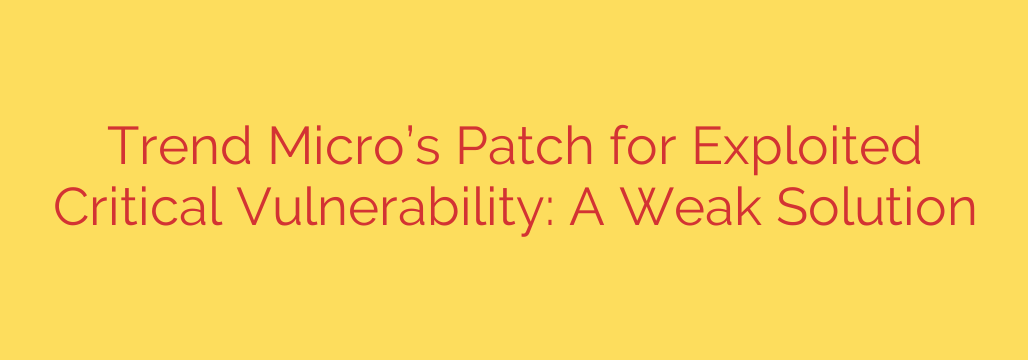
Urgent Security Alert: Critical Trend Micro Flaw Under Active Attack, Patch Falls Short
A critical vulnerability in several Trend Micro enterprise security products is being actively exploited by attackers, creating a significant risk for organizations worldwide. While a patch has been released, security analysis indicates it may not be a complete solution, leaving many systems in a potentially vulnerable state.
This security flaw affects Trend Micro Apex One (both on-premise and SaaS) and Worry-Free Business Security products. The vulnerability is particularly dangerous because it allows an authenticated attacker to bypass security checks and achieve remote code execution (RCE) on affected servers. This means a threat actor who has gained initial access can take full control of a core security component within your network.
Given that this vulnerability is already being used in real-world attacks, immediate action is necessary.
The Core Vulnerability: Bypassing the Defenses
The flaw resides in the agent management component of the security software. Attackers who have already compromised a low-level account can exploit this vulnerability to escalate their privileges. By sending a specially crafted request to the server, they can bypass security mechanisms designed to validate commands.
Once bypassed, the attacker can execute arbitrary code with the privileges of the system itself. This gives them a powerful foothold to:
- Deploy ransomware across the network.
- Steal sensitive corporate or customer data.
- Disable security controls to hide their activity.
- Move laterally to other critical systems.
What makes this situation especially urgent is the active exploitation. Attackers are not just theoretically capable of using this flaw—they are actively using it now.
Why the Official Patch Is a Serious Concern
Trend Micro responded by releasing a security patch to address the issue. However, detailed analysis of the patch reveals a significant problem: it appears to be a weak or incomplete fix.
Instead of addressing the root cause of the vulnerability, the patch seems to implement a filter to block the specific exploit technique that was first discovered. While this stops the known method of attack, it does not fix the underlying logical error in the code.
This type of “blocklist” patching is a short-term solution at best. Sophisticated attackers can often develop new exploit methods to bypass these simple filters, re-opening the vulnerability on systems that have already been patched. Relying solely on this patch may create a false sense of security while the fundamental risk remains.
How to Protect Your Organization Now
Given the active threat and the potential weakness of the patch, a multi-layered defense strategy is essential. Simply applying the update and moving on is not enough. Follow these critical steps to secure your environment:
Apply the Patch Immediately: Despite its limitations, the official patch is your first line of defense. It will protect your systems from the current, known exploit method being used by attackers. Do not delay this step.
Implement Enhanced Monitoring: Since the patch may be bypassed, you must assume a breach is still possible. Closely monitor your Apex One or Worry-Free servers for any unusual activity. Look for unexpected processes, suspicious network connections, or unauthorized administrative actions.
Restrict Server Access: Enforce the principle of least privilege. Ensure the management console of your security server is not exposed to the open internet. Access should be strictly limited to a small number of trusted administrators connecting from secure, internal networks.
Review System Logs: Proactively hunt for signs of compromise that may have occurred before the patch was applied. Analyze historical logs for any indicators of the known exploit or other suspicious authentication patterns related to the vulnerable component.
Prepare Your Incident Response: Treat this as a high-priority threat. Ensure your incident response plan is up-to-date and your team is prepared to act if a compromise is detected. Quick detection and response are key to minimizing potential damage.
In the fast-evolving world of cybersecurity, vigilance is paramount. While vendor patches are crucial, they are only one part of a robust security posture. It is essential to remain informed, monitor for new developments, and be prepared for threat actors to adapt their techniques. Continue to watch for a more comprehensive patch from the vendor, but in the meantime, take these proactive steps to defend your network.
Source: https://go.theregister.com/feed/www.theregister.com/2025/08/10/infosec_in_brief/








